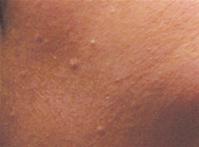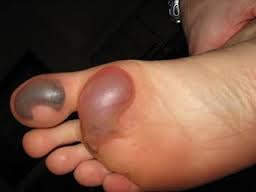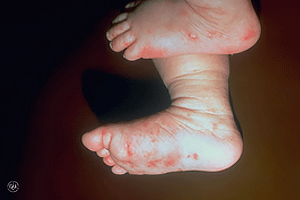

A comparison of intravenous ibuprofen and indomethacin for the treatment of patent ductus arteriosus showed a significant decrease in mesenteric and renal blood flow velocity 30 minutes after administration as measured by Doppler ultrasonography. In addition, ibuprofen has not been shown to alter mesenteric blood flow. However, its effects are primarily on thromboxane inhibition, with only mild inhibitory effects on prostaglandin. Similar to indomethacin, ibuprofen is also classified as a nonsteroidal anti-inflammatory drug. In contrast, ibuprofen had no effect on burning scrotum syndrome in this patient. Given the close proximity of the testicular artery to the mesenteric arteries, we speculate that indomethacin exerts similar vasoconstrictive effects on the testicular vasculature, resulting in its profound effects on burning scrotum syndrome. The superior mesenteric artery arises above (L1), and the inferior mesenteric artery arises below (元) the level of the testicular arteries from the abdominal aorta.
:max_bytes(150000):strip_icc()/GettyImages-806396984-5afca5c5119fa80037e563e6.jpg)
6 The testicular arteries arise directly from the aorta, typically at the L2-元 vertebral levels. Indomethacin has been shown to have the greatest vasoconstrictive effects in the ileocecal area and to increase mesenteric vascular resistance. Indomethacin is a nonsteroidal anti-inflammatory drug inhibiting prostaglandin synthesis and causing vasoconstriction. We report rapid improvement of burning scrotum syndrome with the use of indomethacin. 5 On histology, telangiectasia without prominent inflammation can be seen, but there are no pathognomonic findings. These include prolonged topical corticosteroid use, leading to rebound vasodilation, neurogenic inflammation, and localized erythromelalgia. The exact cause of burning scrotum syndrome is yet to be determined, but various mechanisms have been proposed. Five months after commencing the indomethacin treatment, his burning scrotum resolved, and no more indomethacin was required.īurning scrotum syndrome typically affects males in their second half of life. However, the intensity of flares gradually decreased and responded to lower amounts of indomethacin, sometimes as low as a single dose of indomethacin 50 mg. After discontinuing the medication, the patient experienced occasional minor flares, for which he initially took indomethacin 50 mg twice daily for a few days, then 50 mg 3 times per week. He was then instructed to continue indomethacin 50 mg twice daily for an additional 2 weeks, and then to stop. At the 4-week follow up, the patient reported complete remission of symptoms by that point, he had self-reduced the dose to 50 mg twice daily due to minor gastrointestinal discomfort. The patient reported improvement of both pain and erythema (60%-70%) by 10 days of indomethacin treatment.

Topical menthol/camphor was used as needed for symptom relief. Therefore, doxycycline was discontinued, and indomethacin 50 mg 3 times daily was initiated.

Doxycycline 100 mg twice daily and 0.5% topical menthol/0.5% camphor were tried for 2 months however, no improvement was seen apart from partial, temporary relief with menthol/camphor. The diagnosis of red scrotum syndrome was made based on appearance and symptoms.
#Tiny balls that itch on feet Patch
Physical examination revealed a well-marginated inflammatory red patch limited to the scrotum. Systemic steroids were previously prescribed and helped briefly. Ibuprofen 400 mg twice daily was trialed at the onset of symptoms, without any improvement. While the azithromycin 1 gram one time helped achieve complete resolution for a week, the remainder of the therapies did not result in any improvements. Other previous treatment attempts included azithromycin, moxifloxacin, betamethasone, acrolimus, and crisaborole. While the rash improved, the discomfort at the penis continued, and the pain began to radiate to the scrotal area. He had been treated for an unknown rash at the tip and body of the penis 1.5 years previously with nystatin and saline. A 41-year-old man presented to the Mayo Clinic for scrotal pain and erythema with burning sensations.


 0 kommentar(er)
0 kommentar(er)
